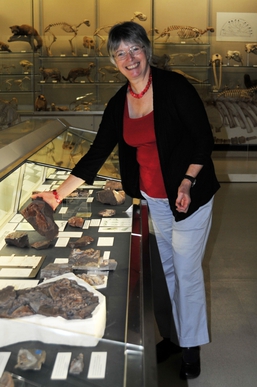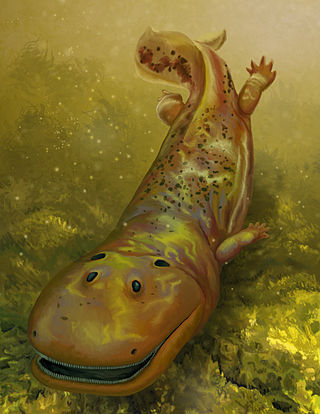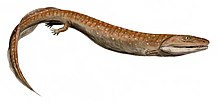
The Carboniferous is a geologic period and system of the Paleozoic that spans 60 million years from the end of the Devonian Period 358.9 Ma to the beginning of the Permian Period, 298.9 Ma. In North America, the Carboniferous is often treated as two separate geological periods, the earlier Mississippian and the later Pennsylvanian.

A tetrapod is any four-limbed vertebrate animal of the superclass Tetrapoda. Tetrapods include all extant and extinct amphibians and amniotes, with the latter in turn evolving into two major clades, the sauropsids and synapsids. Some tetrapods such as snakes, legless lizards, and caecilians had evolved to become limbless via mutations of the Hox gene, although some do still have a pair of vestigial spurs that are remnants of the hindlimbs.

Sarcopterygii — sometimes considered synonymous with Crossopterygii — is a taxon of the bony fish known as the lobe-finned fish or sarcopterygians, characterised by prominent muscular limb buds (lobes) within the fins, which are supported by articulated appendicular skeletons. This is in contrast to the other clade of bony fish, the Actinopterygii, which have only skin-covered bony spines (lepidotrichia) supporting the fins.

Jennifer Alice Clack, was an English palaeontologist and evolutionary biologist. She specialised in the early evolution of tetrapods, specifically studying the "fish to tetrapod" transition: the origin, evolutionary development and radiation of early tetrapods and their relatives among the lobe-finned fishes. She is best known for her book Gaining Ground: the Origin and Early Evolution of Tetrapods, published in 2002 and written with the layperson in mind.

"Labyrinthodontia" is an informal grouping of extinct predatory amphibians which were major components of ecosystems in the late Paleozoic and early Mesozoic eras. Traditionally considered a subclass of the class Amphibia, modern classification systems recognize that labyrinthodonts are not a formal natural group (clade) exclusive of other tetrapods. Instead, they consistute an evolutionary grade, ancestral to living tetrapods such as lissamphibians and amniotes. "Labyrinthodont"-grade vertebrates evolved from lobe-finned fishes in the Devonian, though a formal boundary between fish and amphibian is difficult to define at this point in time.
The Hangenberg event, also known as the Hangenberg crisis or end-Devonian extinction, is a mass extinction that occurred at the end of the Famennian stage, the last stage in the Devonian Period. It is usually considered the second-largest extinction in the Devonian Period, having occurred approximately 13 million years after the Late Devonian mass extinction at the Frasnian-Famennian boundary. The event is named after the Hangenberg Shale, which is part of a sequence that straddles the Devonian-Carboniferous boundary in the Rhenish Massif of Germany.

Whatcheeriidae is an extinct family of stem-tetrapods which lived in the Mississippian sub-period, a subdivision of the Carboniferous period. It contains the genera Pederpes, Whatcheeria, and possibly Ossinodus. Fossils of a possible whatcheeriid have been found from the Red Hill locality of Pennsylvania. If these remains are from a whatcheeriid, they extend the range of the family into the Late Devonian and suggest that advanced tetrapods may have lived alongside primitive tetrapod ancestors like Hynerpeton and Densignathus. They also imply that a very long ghost lineage of whatcheeriids lived through Romer's gap, a period during the Early Carboniferous conspicuously lacking in tetrapod remains.

Pederpes is an extinct genus of early Carboniferous tetrapod, dating from 348 to 347.6 Ma in the Tournaisian age. Pederpes contains one species, P. finneyae, 1 m long.

Spathicephalus is an extinct genus of stem tetrapods that lived during the middle of the Carboniferous Period. The genus includes two species: the type species S. mirus from Scotland, which is known from two mostly complete skulls and other cranial material, and the species S. pereger from Nova Scotia, which is known from a single fragment of the skull table. Based on the S. mirus material, the appearance of Spathicephalus is unlike that of any other early tetrapod, with a flattened, square-shaped skull and jaws lined with hundreds of very small chisel-like teeth. However, Spathicephalus shares several anatomical features with a family of stem tetrapods called Baphetidae, leading most paleontologists who have studied the genus to place it within a larger group called Baphetoidea, often as part of its own monotypic family Spathicephalidae. Spathicephalus is thought to have fed on aquatic invertebrates through a combination of suction feeding and filter feeding.

Ichthyostegalia is an order of extinct amphibians, representing the earliest landliving vertebrates. The group is thus an evolutionary grade rather than a clade. While the group are recognized as having feet rather than fins, most, if not all, had internal gills in adulthood and lived primarily as shallow water fish and spent minimal time on land.

The evolution of tetrapods began about 400 million years ago in the Devonian Period with the earliest tetrapods evolved from lobe-finned fishes. Tetrapods are categorized as animals in the biological superclass Tetrapoda, which includes all living and extinct amphibians, reptiles, birds, and mammals. While most species today are terrestrial, little evidence supports the idea that any of the earliest tetrapods could move about on land, as their limbs could not have held their midsections off the ground and the known trackways do not indicate they dragged their bellies around. Presumably, the tracks were made by animals walking along the bottoms of shallow bodies of water. The specific aquatic ancestors of the tetrapods, and the process by which land colonization occurred, remain unclear. They are areas of active research and debate among palaeontologists at present.
Blue Beach is a 2 kilometres (1.2 mi) stretch of cliff-bordered coastline at Avonport, Nova Scotia near the mouth of the along the Avon River in the southern bight of Minas Basin, Kings County, Nova Scotia, Canada. It is best known as a globally significant fossil location for Lagerstätte of the Tournaisian Stage period.

Occidens is an extinct genus of stem tetrapod from the Early Carboniferous (Tournaisian) Altagoan Formation of Northern Ireland. It is known from a single type species, Occidens portlocki, named in 2004 on the basis of a left lower jaw described by British geologist Joseph Ellison Portlock in 1843.

The Ballagan Formation is a geologic formation in Scotland and England. It preserves fossils dating back to the early part of the Carboniferous period. Its name comes from the "Ballagan Beds" of Ballagan Glen, near Strathblane, which has a good example of this geological formation.
The arthropod gap is an apparent gap in the arthropod fossil record used in the study of evolutionary biology. It still occurs in the early Carboniferous, coinciding and extending past the Romer's gap for tetrapods, who were newly arriving on land.
Aytonerpeton is an extinct genus of stem-tetrapod from the Ballagan Formation of Scotland. It was one of five new genera of early limbed vertebrates from the Ballagan Formation described by Clack et al. in 2016. These vertebrates were among the only known in the world from a period of time known as Romer's gap. Romer's gap, which spans most of the Mississippian age of the Carboniferous, is characterized by a comparative rarity of tetrapod and stem-tetrapod fossils compared to the periods of time directly older and younger than it. However, Aytonerpeton and other Ballagan stem-tetrapods help to close in this gap in the vertebrate fossil record.

Stan Wood was a self-taught fossil hunter known for his significant palaeontological discoveries at scale and is arguably most celebrated for refocusing attention on early Carboniferous palaeobiology as the means to closing Romer's gap.
Ossirarus is an extinct genus of four-limbed stem-tetrapod from the Mississippian (mid-Tournaisian) of Scotland. It contains a single species, Ossirarus kierani, based on disarticulated skull and postcranial bones from the Ballagan Formation at Burnmouth. It would have had a large, pointed tabular horn and several minor traits shared with Devonian stem-tetrapods. Ossirarus was described in a 2016 study which was devised to fill in the tetrapod and stem-tetrapod faunas of Romer's gap, an interval of the early Carboniferous with few vertebrate fossils. It was one of five new genera named in this study, along with Aytonerpeton, Diploradus, Koilops, and Perittodus.
Perittodus is an extinct genus of four-limbed stem-tetrapod from the Mississippian (mid-Tournaisian) of Scotland. It contains a single species, Perittodus apsconditus, based on disarticulated skull and postcranial bones from the Ballagan Formation. The lower jaw of the holotype specimen was about 6.8 cm in length and had a pattern of dentition similar to the Devonian taxon Ymeria. Perittodus was described in a 2016 study which was devised to fill in the tetrapod and stem-tetrapod faunas of Romer's gap, an interval of the early Carboniferous with few vertebrate fossils. It was one of five new genera named in this study, along with Aytonerpeton, Diploradus, Koilops, and Ossirarus.
The evolution of fishes took place over a timeline which spans the Cambrian to the Cenozoic, including during that time in particular the Devonian, which has been dubbed the "age of fishes" for the many changes during that period.




















